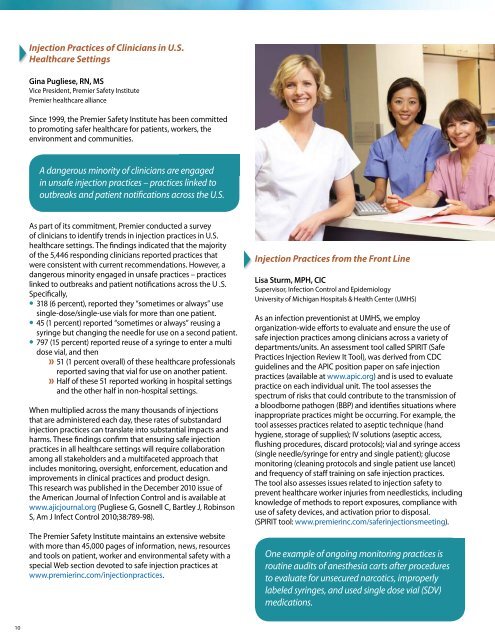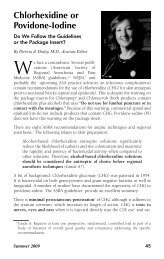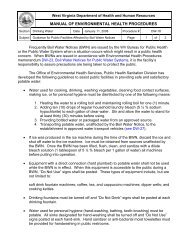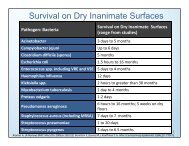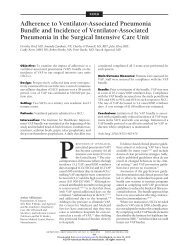Safer Designs for Safer Injections: - Premier healthcare alliance
Safer Designs for Safer Injections: - Premier healthcare alliance
Safer Designs for Safer Injections: - Premier healthcare alliance
Create successful ePaper yourself
Turn your PDF publications into a flip-book with our unique Google optimized e-Paper software.
Injection Practices of Clinicians in U.S.<br />
Healthcare Settings<br />
Gina Pugliese, RN, MS<br />
Vice President, <strong>Premier</strong> Safety Institute<br />
<strong>Premier</strong> <strong>healthcare</strong> <strong>alliance</strong><br />
Since 1999, the <strong>Premier</strong> Safety Institute has been committed<br />
to promoting safer <strong>healthcare</strong> <strong>for</strong> patients, workers, the<br />
environment and communities.<br />
A dangerous minority of clinicians are engaged<br />
in unsafe injection practices – practices linked to<br />
outbreaks and patient notifications across the U.S.<br />
As part of its commitment, <strong>Premier</strong> conducted a survey<br />
of clinicians to identify trends in injection practices in U.S.<br />
<strong>healthcare</strong> settings. The findings indicated that the majority<br />
of the 5,446 responding clinicians reported practices that<br />
were consistent with current recommendations. However, a<br />
dangerous minority engaged in unsafe practices – practices<br />
linked to outbreaks and patient notifications across the U .S.<br />
Specifically,<br />
• 318 (6 percent), reported they “sometimes or always” use<br />
single-dose/single-use vials <strong>for</strong> more than one patient.<br />
• 45 (1 percent) reported “sometimes or always” reusing a<br />
syringe but changing the needle <strong>for</strong> use on a second patient.<br />
• 797 (15 percent) reported reuse of a syringe to enter a multi<br />
dose vial, and then<br />
» 51 (1 percent overall) of these <strong>healthcare</strong> professionals<br />
reported saving that vial <strong>for</strong> use on another patient.<br />
» Half of these 51 reported working in hospital settings<br />
and the other half in non-hospital settings.<br />
When multiplied across the many thousands of injections<br />
that are administered each day, these rates of substandard<br />
injection practices can translate into substantial impacts and<br />
harms. These findings confirm that ensuring safe injection<br />
practices in all <strong>healthcare</strong> settings will require collaboration<br />
among all stakeholders and a multifaceted approach that<br />
includes monitoring, oversight, en<strong>for</strong>cement, education and<br />
improvements in clinical practices and product design.<br />
This research was published in the December 2010 issue of<br />
the American Journal of Infection Control and is available at<br />
www.ajicjournal.org (Pugliese G, Gosnell C, Bartley J, Robinson<br />
S, Am J Infect Control 2010;38:789-98).<br />
The <strong>Premier</strong> Safety Institute maintains an extensive website<br />
with more than 45,000 pages of in<strong>for</strong>mation, news, resources<br />
and tools on patient, worker and environmental safety with a<br />
special Web section devoted to safe injection practices at<br />
www.premierinc.com/injectionpractices.<br />
Injection Practices from the Front Line<br />
Lisa Sturm, MPH, CIC<br />
Supervisor, Infection Control and Epidemiology<br />
University of Michigan Hospitals & Health Center (UMHS)<br />
As an infection preventionist at UMHS, we employ<br />
organization-wide ef<strong>for</strong>ts to evaluate and ensure the use of<br />
safe injection practices among clinicians across a variety of<br />
departments/units. An assessment tool called SPIRIT (Safe<br />
Practices Injection Review It Tool), was derived from CDC<br />
guidelines and the APIC position paper on safe injection<br />
practices (available at www.apic.org) and is used to evaluate<br />
practice on each individual unit. The tool assesses the<br />
spectrum of risks that could contribute to the transmission of<br />
a bloodborne pathogen (BBP) and identifies situations where<br />
inappropriate practices might be occurring. For example, the<br />
tool assesses practices related to aseptic technique (hand<br />
hygiene, storage of supplies); IV solutions (aseptic access,<br />
flushing procedures, discard protocols); vial and syringe access<br />
(single needle/syringe <strong>for</strong> entry and single patient); glucose<br />
monitoring (cleaning protocols and single patient use lancet)<br />
and frequency of staff training on safe injection practices.<br />
The tool also assesses issues related to injection safety to<br />
prevent <strong>healthcare</strong> worker injuries from needlesticks, including<br />
knowledge of methods to report exposures, compliance with<br />
use of safety devices, and activation prior to disposal.<br />
(SPIRIT tool: www.premierinc.com/saferinjectionsmeeting).<br />
One example of ongoing monitoring practices is<br />
routine audits of anesthesia carts after procedures<br />
to evaluate <strong>for</strong> unsecured narcotics, improperly<br />
labeled syringes, and used single dose vial (SDV)<br />
medications.<br />
10


